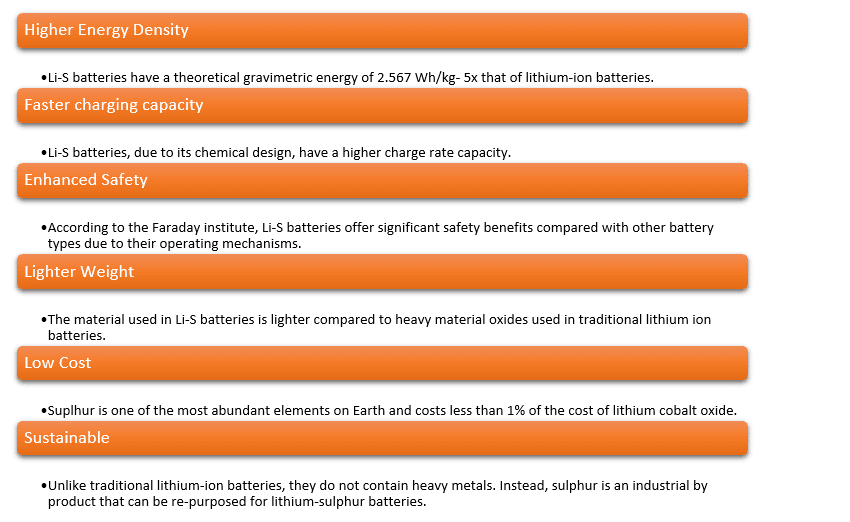“Unlocking the Promising Future: Exploring the Advancements and Potential of Lithium-Sulphur Batteries”
Lithium-ion batteries commercially used are mainly composed of cathode, anode separator and electrolyte. Lithium-ion batteries are installed in smartphones, power tools, and EVs. They use liquid electrolyte solution.
Despite its wide scale use and improvements in Lithium-ion battery technology, they have familiar drawbacks as well, such as overheating, and supply chain problems with raw materials. There is ongoing research into those problems by testing new materials in the construction of batteries. One such material is Sulphur, due to its extreme abundance in nature, a by-product of the oil industry. The material is also cost effective and has the ability to hold more energy than traditional lithium-ion-based batteries.
The worldwide sulfur-based battery market size is expected to grow with a CAGR of 17.69%, reaching US$ 2,699 million by 2031 from 517.4 million in 2021.
Access sample report (including graphs, charts, and figures): https://univdatos.com/get-a-free-sample-form-php/?product_id=12413
Components of a battery–
Electrodes– The electrode that releases electrons during discharge is an anode; the electrode that absorbs the electrons is the cathode. They store lithium. The electrolyte carries positively charged lithium ions (i.e., an ion is an electrically charged particle produced to give a positive or negative ion by either removing or adding electrons from a neutral atom) from the anode to the cathode and vice versa through the separator. The movement of lithium ions creates free electrons in the anode, creating a charge that flows electric current through a device being powered. Electrodes are responsible for the basic performance of the battery.
Separator and Electrolyte– These two determine the safety of a battery. The separator acts as a physical barrier between cathode and anode, preventing the direct flow of electrons between them, blocking the flow of electrons inside the battery, leaving only ions to pass through them.
The electrolyte transfers ions (charge carrying particles) back and forth between the battery’s two electrodes, causing the battery to charge and discharge.
Challenge in the practical use of Lithium-Sulphur batteries
Charging the Li-S battery results in a build-up material (Polysulfide) which then flows and dissolves into the electrolyte, causing its corrosion. Referred by researchers as the polysulfide shuttling effect, it reduces battery life.
To prevent polysulfide shutting, scientists at the beginning tried placing a redox-inactive interlayer between the electrodes. However, it ended up taking additional space within the battery, reducing the storage capacity of the battery and did not adequately reduce shutting. Subsequently, researchers developed a porous sulfur-containing active interlayer as opposed to redox-inactive (i.e., it does not undergo similar reactions as in the electrode). The results showed capacity increased by three times and the batteries with active interlayer maintained high capacity over 700 charge-discharge cycles.
Recent developments in the Sulfur-based Battery market
September 2022: NGK Insulators, Ltd were rewarded with a contract for a 11.4 MW/69.6 MWh sodium sulfur system. The system will be deployed at Tsu LNG station in Mie Prefecture, Japan.
January 2022: Lyten Inc., and U.S. department of Defense signed an agreement. This agreement aims at enhancing the lithium-sulfur batteries for commercial and national safety use.
The Advantages of Lithium-Sulphur-

Conclusion
Lithium-ion batteries are reaching their technological advancement. Li-S batteries have emerged as a solution to the limitations of traditional lithium-ion batteries. Researchers are looking to solve the current challenge of short battery life caused due to polysulfide shutting, by employing sulfide solid-state electrolytes (SSEs). Li-S batteries have high-density energy, enhanced safety, cost effectiveness and the Sulphur used in batteries is an industrial by product.
Author: Abhishek Saini
For more detail Contact:
UnivDatos Market Insights
C80B, Sector-8, Noida,
Uttar Pradesh 201301
For Sales related query, please reach us at [email protected]
